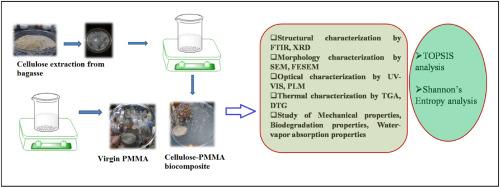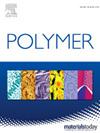An Entropy- TOPSIS Approach To Find PMMA/Cellulose Based Biocomposite With Optimum Mechanical And Bio-Degradation Properties
IF 4.1
2区 化学
Q2 POLYMER SCIENCE
引用次数: 0
Abstract
Poly methyl methacrylate based biocomposite has been manufactured using nanocellulose as reinforcement, which has been extracted from bagasse. The biocomposites are formed by bulk polymerization using benzoyl peroxide as initiator. The composites are evaluated by FTIR, X-ray diffraction, mechanical properties, UV analysis, scanning electron microscope, polarizing light microscope and thermo-gravimetric analysis. Variation in properties is an inherent drawback of natural fibers, for which this MCDM technique is very effective to decipher, the biocomposite with optimum properties. It has been found that when the bagasse fiber is treated with 3.5% of sodium chlorite solution, it can produce biocomposite with PMMA. It has been observed that, cellulose grafting takes place in the PMMA chain in presence of benzoyl peroxide. Further the work has been extended with loading variation of the said cellulose fibers and 1.5% loading has been found as the best. The novelty of the work lies in the fact that these evaluations have been substantiated by Multi-Criteria Decision Making (MCDM) technique involving ENTROPY and TOPSIS approach and successfully selected 1.5 wt. % loading to fabricate the optimum biocomposite. This composite exhibited around 13.5% biodegradation within 90 days. This film can find application in packaging field.

用熵-TOPSIS 法寻找具有最佳机械和生物降解性能的 PMMA/纤维素基生物复合材料
使用从甘蔗渣中提取的纳米纤维素作为增强剂,制造出了基于聚甲基丙烯酸甲酯的生物复合材料。生物复合材料是以过氧化苯甲酰为引发剂,通过体聚合反应形成的。通过傅立叶变换红外光谱、X 射线衍射、机械性能、紫外分析、扫描电子显微镜、偏光显微镜和热重分析对复合材料进行了评估。性能差异是天然纤维固有的缺点,而这种 MCDM 技术可以非常有效地确定具有最佳性能的生物复合材料。研究发现,用 3.5% 的亚氯酸钠溶液处理甘蔗渣纤维后,可与 PMMA 生成生物复合材料。据观察,在过氧化苯甲酰存在的情况下,PMMA 链中会发生纤维素接枝。此外,这项研究还对纤维素纤维的负载量进行了扩展,发现 1.5% 的负载量是最佳的。这项工作的新颖之处在于,这些评估已通过涉及 ENTROPY 和 TOPSIS 方法的多标准决策(MCDM)技术得到证实,并成功地选择了 1.5 wt.这种复合材料在 90 天内的生物降解率约为 13.5%。这种薄膜可应用于包装领域。
本文章由计算机程序翻译,如有差异,请以英文原文为准。
求助全文
约1分钟内获得全文
求助全文
来源期刊

Polymer
化学-高分子科学
CiteScore
7.90
自引率
8.70%
发文量
959
审稿时长
32 days
期刊介绍:
Polymer is an interdisciplinary journal dedicated to publishing innovative and significant advances in Polymer Physics, Chemistry and Technology. We welcome submissions on polymer hybrids, nanocomposites, characterisation and self-assembly. Polymer also publishes work on the technological application of polymers in energy and optoelectronics.
The main scope is covered but not limited to the following core areas:
Polymer Materials
Nanocomposites and hybrid nanomaterials
Polymer blends, films, fibres, networks and porous materials
Physical Characterization
Characterisation, modelling and simulation* of molecular and materials properties in bulk, solution, and thin films
Polymer Engineering
Advanced multiscale processing methods
Polymer Synthesis, Modification and Self-assembly
Including designer polymer architectures, mechanisms and kinetics, and supramolecular polymerization
Technological Applications
Polymers for energy generation and storage
Polymer membranes for separation technology
Polymers for opto- and microelectronics.
 求助内容:
求助内容: 应助结果提醒方式:
应助结果提醒方式:


